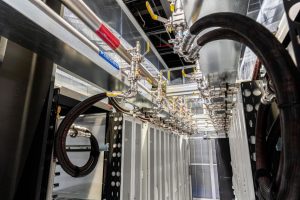As data centers continue to grow in size and complexity, the demand for more efficient and reliable cooling solutions is increasing. Traditionally, air cooling has been the industry standard, but with ever-increasing computing power needed for advancements like Artificial Intelligence (AI), air-cooled systems are struggling to keep up with the heat generated by modern servers, so liquid cooling systems are becoming a preferred alternative to traditional air cooling methods. This innovative approach effectively manages the heat generated by high-powered CPU and GPU chips, particularly in AI technologies.

Stainless steel is now being specified for a number of data center liquid cooling system components used in Coolant Distribution Units (CDU’s), in-row manifolds, and in-rack manifolds across a variety of direct cooling designs, including Direct-to-Chip (D2C) and Immersion systems.
Beyond the coolant, sensors, and controls used in liquid cooling systems, key stainless steel components and their usage include:
Tubing: Corrosion-resistant and hygienic stainless steel tubing for carrying and distributing coolant. While 316 stainless steel is often preferred, 304 is occasionally considered given its lower cost. Most CDU and manifold designs require custom fabrication of tubing to minimize space within the cramped quarters of a CDU, server rack, or data center in general.
Fittings and Connectors: Similar to tubing, stainless steel fittings and connectors ensure leak-proof connections between components along with the ability to withstand high-pressure and high-temperature applications.
Control Valves: Stainless steel valves are used for controlling the flow of coolant within the system.
Filters and Strainers: Stainless steel strainers and filters are often incorporated to remove contaminants and maintain performance of the cooling system.
Pumps: Stainless steel pumps are used to circulate the coolant throughout the system.
When designing a stainless steel liquid cooling system for data centers, it’s essential to consider factors such as thermal efficiency, scalability, maintenance requirements, and compatibility with existing infrastructure. Additionally, adherence to industry standards and guidelines ensures the system operates safely and reliably over its lifecycle.

